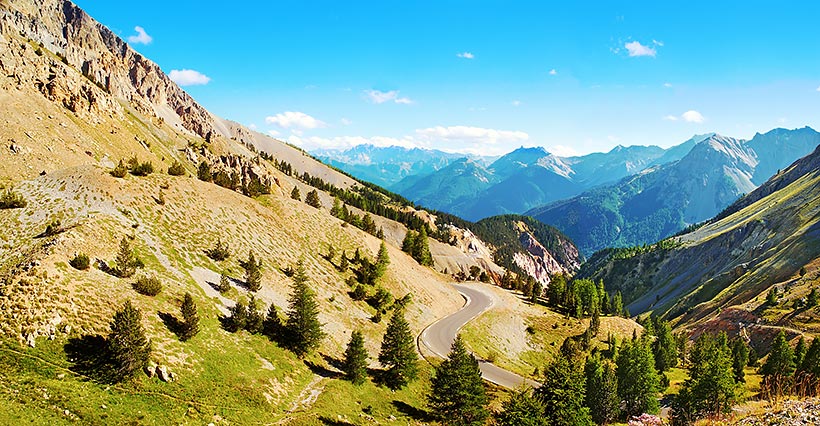Col d’Izoard
The Col d’Izoard is one of the giants of the Southern Alps and a great monument of the Tour de France. The barren slopes of the Col d’Izoard have played host to some of the most memorable moments in history of the Tour de France.
It is accessible in summer via the D902 road, connecting Briançon on the north and the valley of the Guil in Queyras, which ends at Guillestre in the south. There are forbidding and barren scree slopes with protruding pinnacles of weathered rock on the upper south side. Known as the Casse Déserte, this area has formed a dramatic backdrop to some key moments in the Tour de France, and often featured in many iconic 1950s black-and-white photos of the race.
On both sides mountain pass cycling milestones are placed every km. They indicate the current height, the height of the summit, the distance to the summit, as well as the average slope in the following km.
Several of the Tour de France's more memorable moments have occurred on the Col d'Izoard, particularly the exploits of Fausto Coppi, Bernard Thevenet and Louison Bobet.
There have been countless battles on this climb, one of the most recent being when Andy Schleck attacked on the Col d'Izoard and caught his team mate Maxine Montfort. They rode together over the top and then they shared the pace up the Lauteret and then Andy Schleck went onto a lone win at the top of the Col du Galibier.
- FIGURES
- FACTS
-
Region: Hautes-Alpes, Southern Alps, France
Open: May/June to November
Access: From Briancon (follow the D902 along the Cerveyrette in the direction of Guillestre and La Combe de Queyras.
Height: 2,360m
Length: 19.2km
Altitude Gain: 1,136m
Average Gradient: 5.92%
Maximum Gradient: 8.6% (km 13)
Refreshments: At km 18 you will find Refuge Napoleon, open from June until September.
-
The Tour de France uses the Col d'Izoard regularly, being first ascended in 1922.
Philippe Thys was the first rider over the crest.
On stage 10 of the 1923 Tour de France Henri Pélissier attacked his teammate Ottavio Bottecchia on the Izoard. Bottecchia was in the Yellow Jersey, but teams didn't have the cohesion they developed in the 1930s. Pélissier took the lead that day and held it to Paris.
Fausto Coppi, who in 1949 became the first rider to win the Tour de France and Giro d’Italia in the same year, and Louison Bobet, the first rider to win three Tours in succession in 1953, 1954 and 1955, both launched race-defining attacks on the Col d’Izoard, also known as the Casse Desert.
The Col d’izzard has featured in multiple editions of the Tour de France, Giro d’Italia and Criterium du Dauphine.
Levi Leipheimer was in the leader's jersey on the Izoard in the 2006 Dauphine.
The Giro d’Italia has ascended it several times, including 1949, 1964, 1994, 2000 and 2007.
In that incredible 1989 Tour, Greg LeMond gained a precious 13 seconds on Laurent Fignon in stage 16 that went over the Izoard before finishing in Brandon.
A small cycling museum is at the summit, along with a memorial to Coppi and Bobet.
The north face of the Col d’Izoard may not have had quite as much of the Tour de France limelight as its southern ascent.
The surface of the road is asphalt, and chains or snow tyres can be required anytime.
Conveniently there is a car park located right at the foot of the climb in the centre of Brandon.


